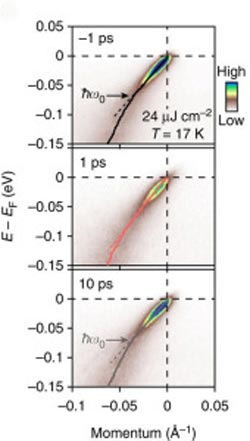A Quick Look at Electron-Boson Coupling

These trARPES spectra of doped Bi2212 show photoemission intensity before pumping (t= −1 ps) and after pumping (t=1 and t=10 ps). The arrows mark the position of a kink that signifies the coupling of the electrons to bosons.
Imagine being able to tune the properties of a solid material just by flashing pulses of light on it, for example turning an insulator into a superconductor. That is just one potential payoff down-the-road from the physical phenomenon of electrons and atoms interacting with ultrashort pulses of light.
The technology of ultrafast spectroscopy is a key to understanding this phenomenon and now a new wrinkle to that technology has been introduced by Berkeley Lab researchers.
In a study led by Alessandra Lanzara of Berkeley Lab’s Materials Sciences Division, time- and angle-resolved photoemission spectroscopy (trARPES) was used to directly measure the ultrafast response of electron self-energy – a fundamental quantity used to describe “many-body” interactions in a material – to photo-excitation with near-infrared light in a high-temperature superconductor.
The results demonstrated a link between the phenomena of electron-boson coupling and superconductivity. A boson can be a force-carrying particle, such as a photon, or composite particle of matter, such an atomic nucleus with an even number of protons and neutrons.
“Below the critical temperature of the superconductor, ultrafast excitations triggered a synchronous decrease of electron self-energy and the superconducting energy gap that continued until the gap was quenched,” says Lanzara. “Above the critical temperature of the superconductor, electron–boson coupling was unresponsive to ultrafast excitations. These findings open a new pathway for studying transient self-energy and correlation effects in solids, such as superconductivity.”
The study of electrons and atoms interacting with intense, ultra-short optical pulses is an emerging field of physics because of the roles these interactions play in modulating the electronic structures and properties of materials such as high-temperature superconductors. ARPES has been the long-standing technique of choice for studying the electronic structure of a material.
In this technique, beams of ultraviolet or X-ray light striking the surface or interface of a sample material cause the photoemission of electrons at angles and kinetic energies that can be measured to reveal detailed information about the material’s electronic band structures. While extremely powerful, ARPES lacks the temporal component required for studying band structural dynamics.
Lanzara and a collaboration that included Wentao Zhang, lead author of a paper on this work in Nature Communications, added the necessary temporal component in their trARPES study. They applied this technique to a material known as Bi2212, a compound of bismuth, strontium, calcium, and copper oxide that is considered one of the most promising of high-temperature superconductors.
They energized the Bi2212 samples with femtosecond pulses of near-infrared laser light then probed the results with femtosecond pulses of ultra-violet laser light. The delay time between pump and probe pulses was precisely controlled so that the electron-boson coupling and the superconducting gap could be tracked at the same time.
“In cuprate materials such as Bi2212, there is a known kink in the photoemission pattern that signifies the coupling of the electrons to bosons,” says Zhang. “However, whether this kink is related in any way to superconductivity has been highly debated. Our results show that it is.”
Zhang’s Nature Communications paper, for which Lanzara is the corresponding author, is titled “Ultrafast quenching of electron–boson interaction and superconducting gap in a cuprate.” Other co-authors are Choongyu Hwang, Christopher Smallwood, Tristan Miller, Gregory Affeldt, Koshi Kurashima, Chris Jozwiak, Hiroshi Eisak, Tadashi Adachi, Yoji Koike and Dung-Hai Lee.
This research was supported by the U.S. Department of Energy’s Office of Science.
Additional Information
For more about the research of Alessandra Lanzara go here
Media Contact
All latest news from the category: Physics and Astronomy
This area deals with the fundamental laws and building blocks of nature and how they interact, the properties and the behavior of matter, and research into space and time and their structures.
innovations-report provides in-depth reports and articles on subjects such as astrophysics, laser technologies, nuclear, quantum, particle and solid-state physics, nanotechnologies, planetary research and findings (Mars, Venus) and developments related to the Hubble Telescope.
Newest articles

A universal framework for spatial biology
SpatialData is a freely accessible tool to unify and integrate data from different omics technologies accounting for spatial information, which can provide holistic insights into health and disease. Biological processes…

How complex biological processes arise
A $20 million grant from the U.S. National Science Foundation (NSF) will support the establishment and operation of the National Synthesis Center for Emergence in the Molecular and Cellular Sciences (NCEMS) at…

Airborne single-photon lidar system achieves high-resolution 3D imaging
Compact, low-power system opens doors for photon-efficient drone and satellite-based environmental monitoring and mapping. Researchers have developed a compact and lightweight single-photon airborne lidar system that can acquire high-resolution 3D…





















